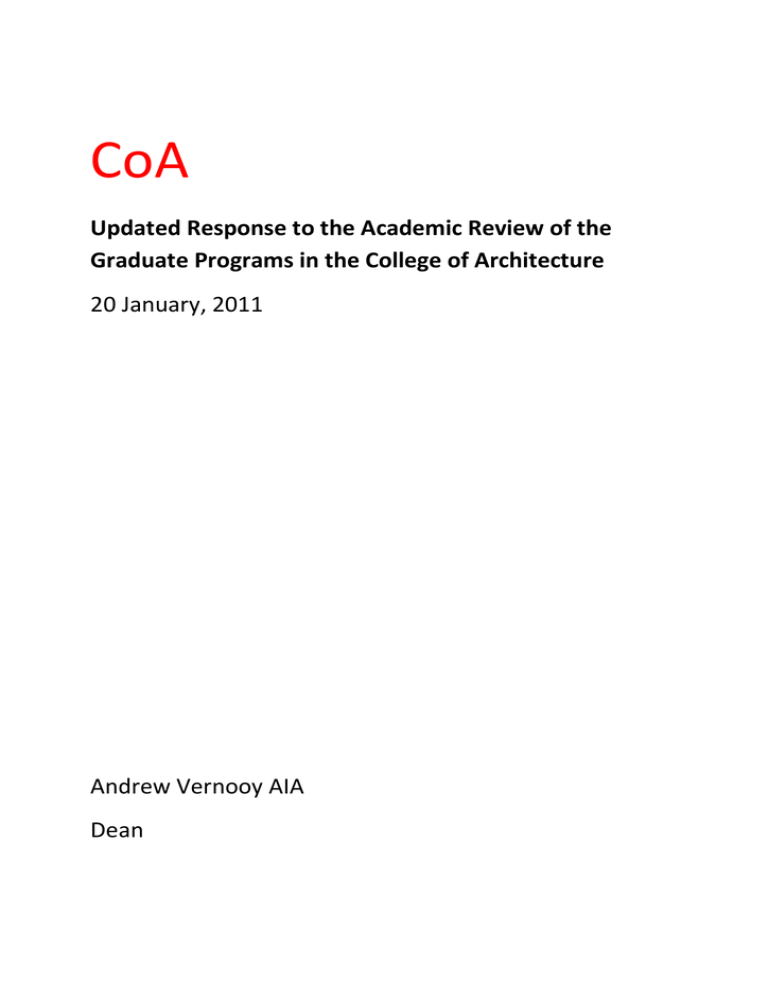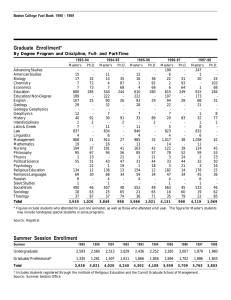CoA Updated Response to the Academic Review of the 20 January, 2011
advertisement

CoA Updated Response to the Academic Review of the Graduate Programs in the College of Architecture 20 January, 2011 Andrew Vernooy AIA Dean Summary (See Nov. 12, 2009 Response from College of Architecture) The College was successfully accredited by the National Architectural Accrediting Board (NAAB) during the spring and summer of 2010. All efforts within the College, during the 2009-2010 academic year, focused on the late April visit by the accrediting team. The NAAB Board met in the summer to give the College a six year term of accreditation. A copy of the Architecture Program Report (APR) has been sent to the Graduate School. The College continues to face the same challenges that it faced when the Graduate School reviewed its three programs in the spring of 2009. Our space is still limited, teaching loads are still too high with little room for conducting research. The Masters of Science in Architecture continues to bring very few students from outside the University. This will not change without a significant infusion of resources to support the restructuring of existing MS Programs and the addition of new programs to meet contemporary needs within the Profession of Architecture. In an effort to expand Graduate enrollment, the College has crafted two new Certificates: Healthcare Architecture and Digital Design and Fabrication. It is in the process of restructuring the old Community Design Program around off campus, practicum experiences in Lubbock, Dallas and Houston, thereby creating an attractive graduate certificate in Urban Design. Similar suggestions have been made for the ailing Historic Preservation Program. The College does not have the funds to increase the financial support of its Graduate Students. Space The College can only hold 820 students. We have developed an Urban Design Studio in Houston and an Urban Design Studio in Lubbock to increase graduate enrollment. We have also initiated a Residency Program that promises to provide very special professional education off campus. This should help increase graduate enrollment as the market for professional Architecture services rebounds. The Healthcare Architecture Program is considered to be a “distance” program that should also bring in mid-career professionals seeking a graduate Certificate in this very lucrative area of work. Teaching Loads While trying to increase funded research in every manner possible it is important to understand that studio teaching, without relief, makes it very difficult to conduct ongoing research projects. The College provides full time staff to assist faculty with proposals, conducting the research and administering the grants. The ongoing State budget crisis has eliminated any opportunities to relieve teaching obligations. Outside Students The College has initiated a program that engages communities in Lubbock, Dallas and Houston as a restructuring of its Community Design Program. Particularly because of the mindshare embedded in Dallas and Houston, soon to be the third largest city in the USA, this program has the opportunity to attract students from other parts of the United States and the World. The College has initiated a Certificate in Healthcare Architecture. Last year Healthcare Architecture was the largest sector of activity in the profession. There are only two established Healthcare Architecture programs in the Country—Texas A&M and Clemson. There aren’t any programs that have direct access to a major hospital, a medical university and a healthcare management program. We have all of these and more. This program will attract students from all over the United States. Curriculum Revision The Professional Architecture Program (MArch) is structured to meet the Student Learning Performances required by the NAAB. This is a very complex and sophisticated set of requirements. Consideration of the curriculum and the new changes that must be made to satisfy the new NAAB standards is not a topic for student’s consideration. Student involvement with these issues would be improper. Associate Dean Rex’s report adequately refutes the contention that changes in the curriculum took place without faculty involvement—over half the faculty were represented on the committees considering the changes and all of the faculty were included in the meetings. In my response, I asked that this reference be removed from the report. Has it been removed? Student Involvement and Inclusion There continues to be student inclusion on most College committees; but the attendance is not good. Last year the Deans of the College met with every cohort of students to insure that the students were apprised of all of the issues facing us during the accreditation year. Further, I led all of the students, by design level, through the team room explaining the curricular and accreditation requirements. Finally, the College held four All-School meetings to address common issues during the last year. Student Support There are no new funds for Graduate Student support. In fact we have lost ground in this area. The only option that the College has is to initiate Differential Tuition. LPMD Landuse Planning Management and Design The report from Dr. Filiz Ozel, reviewing the Ph.D. Program in LPMD was excellent. She suggested that the degree offered an opportunity to fashion a Ph.D. program with a focus on the Design of the environment. She suggested that the program be divided into two tracts— Design and Management—with the first one housed in the College of Architecture. The College held a meeting with the Steering Committee of the program to initially review her recommendations. At that meeting it was decided to stop rolling enrollment and to consider changing the name of the program as “Planning” is an accredited field that is not well represented in this curriculum. I have pointed out that the University is exposed to legal action by the professional organization that represents Planning and by students who graduate from this program thinking that they can be registered as Planners, only to find out that the program does not fulfill the requirements to be a professional program in Planning. The change in enrollment process should address the concerns for low performing programs from the State, as the choice of students can be structured to occur as the various colleges consider the award of financial support. The College has another Steering Committee meeting scheduled for 20, January, 2011.



